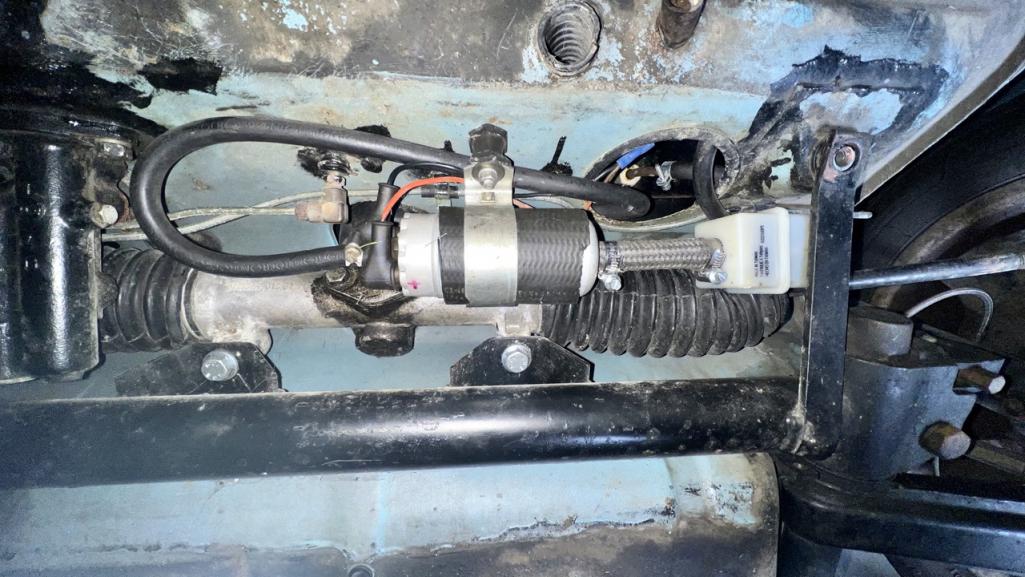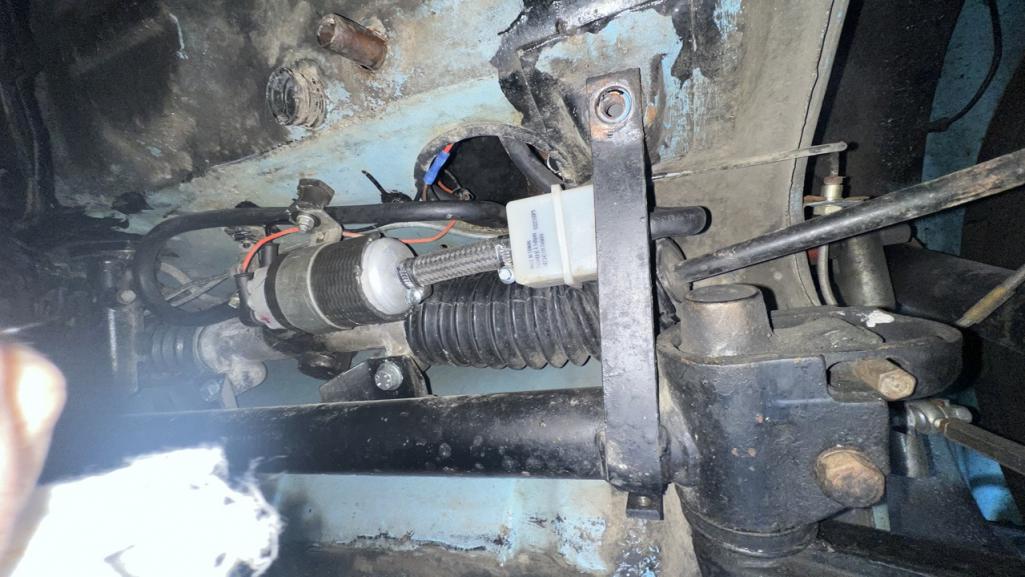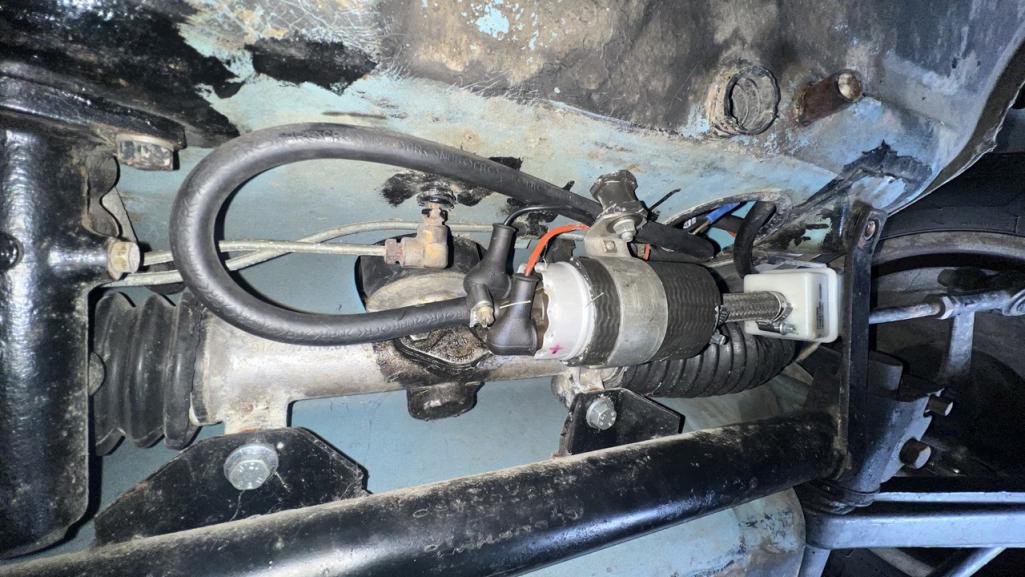Printable Version of Topic
Click here to view this topic in its original format
914World.com _ 914World Garage _ fuel pump relocation under steering rack pictures?
Posted by: Geezer914 Feb 4 2023, 08:57 AM
Anyone relocated the fuel pump and filter under the steering rack with to make it easier to change the fuel filter? Pictures? Thanks
Posted by: Geezer914 Feb 4 2023, 10:57 AM
Thanks for the pic.
Posted by: Literati914 Feb 4 2023, 11:11 AM
I’m planning the same .. any more pics out there? A few different angles would help clear the mind tbh ![]()
![]()
.
Posted by: FlacaProductions Feb 4 2023, 11:46 AM
I know...I know....I don't like the blue crimp connector either but that's the PO's work. I'll get that corrected.
Posted by: mlindner Feb 4 2023, 12:13 PM
Geezer, not what your looking for but just to give you ideas. With my forward install fuel tank I mounted the filter and pump under the tanks for easy service. Mark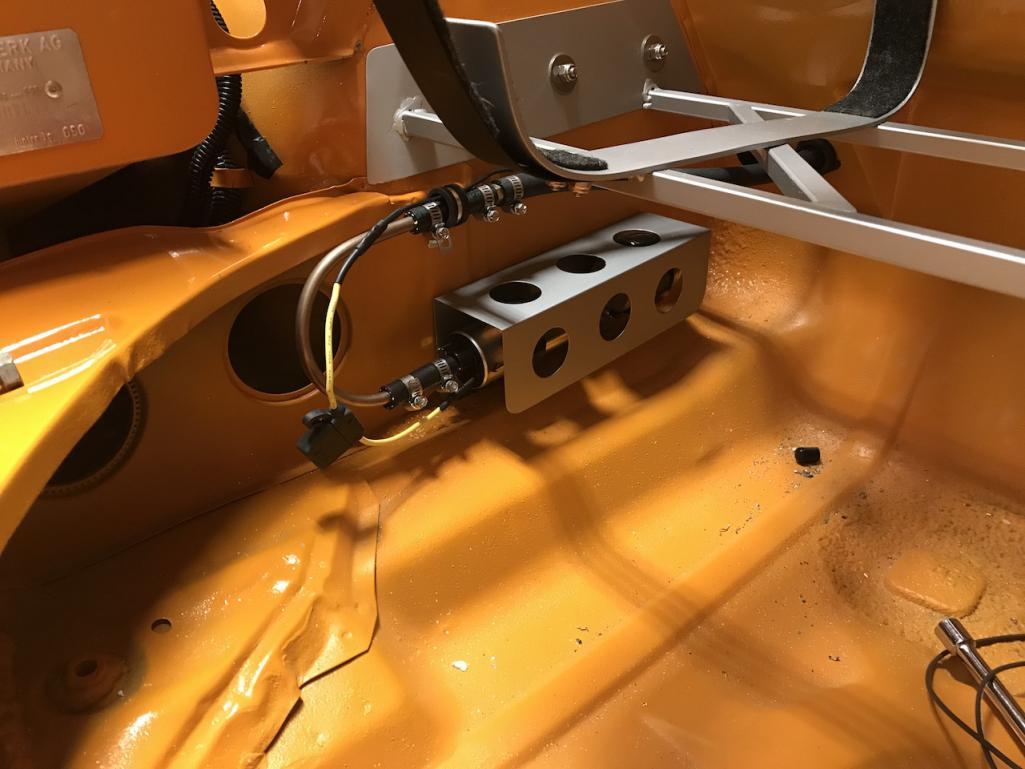
Posted by: roundtwo Feb 4 2023, 12:18 PM
Geezer, not what your looking for but just to give you ideas. With my forward install fuel tank I mounted the filter and pump under the tanks for easy service. Mark

Hello,
Do you have a fuel filter before the fuel enters the fuel pump?
And is that metal bracket to cradle of the spare tire? Nicely done. Thanks.Todd
Posted by: mlindner Feb 4 2023, 12:26 PM
Roundtwo, yes filter always first. And I just cary a small spare.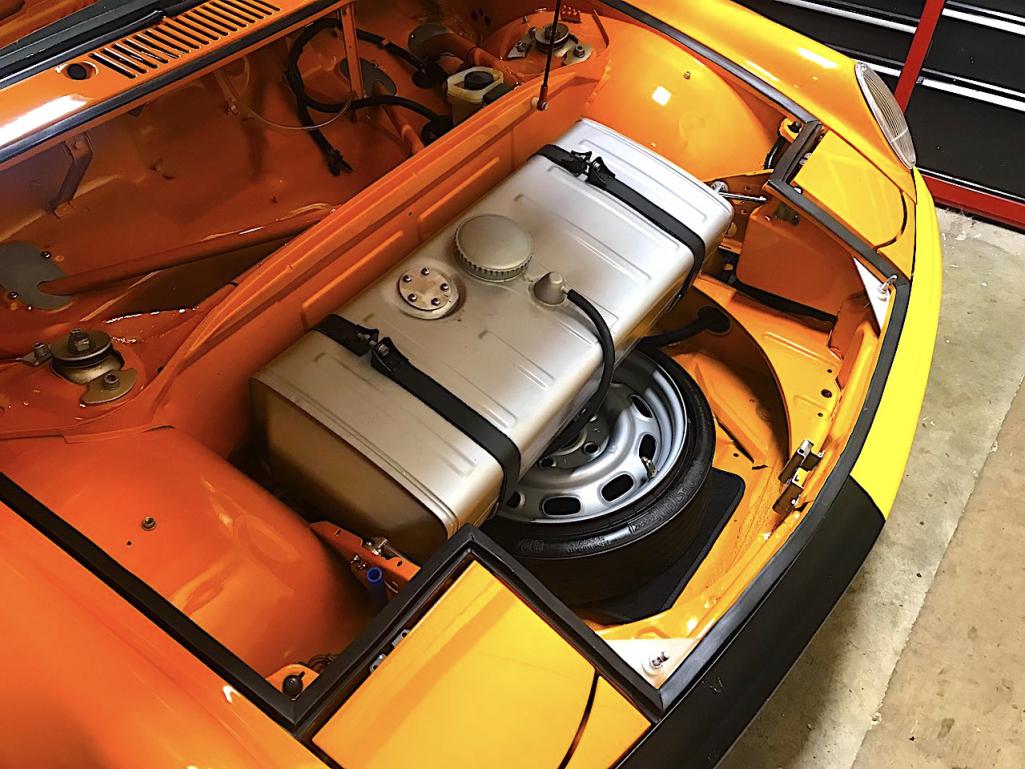
Posted by: rhodyguy Feb 4 2023, 12:26 PM
I would not like having to remove the rack cover piece to simply change the filter or service the lines or the pump. ESP potentially on the side of the road.
Posted by: FlacaProductions Feb 4 2023, 12:47 PM
I would not like having to remove the rack cover piece to simply change the filter or service the lines or the pump. ESP potentially on the side of the road.
I like how protected it is up there.
Posted by: Geezer914 Feb 4 2023, 02:53 PM
Rhodyguy, if the pump or the filter craps out, that is something I would not attempt to fix on the side of the road. With the fuel pump under the gas tank, it's a pia to remove the plate and maneuver the fuel pump with the 12mm fuel line to get the filter out , and stuff everything back in hoping you didn't kink a fuel line. Under the steering rack, you remove 4 bolts and everything is right there. I would like to install a small fuel shutoff valve to make it easy to change the filter.
Posted by: windforfun Feb 4 2023, 03:23 PM
I would not like having to remove the rack cover piece to simply change the filter or service the lines or the pump. ESP potentially on the side of the road.
Posted by: mlindner Feb 4 2023, 04:44 PM
Just pinch the fuel line for that.
Posted by: iankarr Feb 4 2023, 06:20 PM
The factory solution placed the pump in the tank well…with an access cover that could be removed from the frunk. I think that’s the most elegant stock solution. On my bumblebee I located the pump next to the steering rack, but it was tricky to get the hoses routed so there were no kinks. And no impact to the steering.
Posted by: JeffBowlsby Feb 4 2023, 09:03 PM
A concern with the front mounted pumps is that pressurized fuel is now routing through the cabin. I’m not comfortable with that.
Posted by: JamesM Feb 5 2023, 02:41 AM
A concern with the front mounted pumps is that pressurized fuel is now routing through the cabin. I’m not comfortable with that.
Don't own a 75-76 car then i guess.
With a swap to stainless lines and the center tunnel being a mostly enclosed metal tunnel with the few small openings under carpet I think ones chances of being directly exposed to gasoline from having the lines under pressure are very, very low.
At its worst I dont see it as anymore dangerous than anything else about driving a very small 50+ year old car.
Also I find it very preferable to vapor lock, especially on long trips.
Posted by: wonkipop Feb 5 2023, 03:20 AM
A concern with the front mounted pumps is that pressurized fuel is now routing through the cabin. I’m not comfortable with that.
Don't own a 75-76 car then i guess.
With a swap to stainless lines and the center tunnel being a mostly enclosed metal tunnel with the few small openings under carpet I think ones chances of being directly exposed to gasoline from having the lines under pressure are very, very low.
At its worst I dont see it as anymore dangerous than anything else about driving a very small 50+ year old car.
Also I find it very preferable to vapor lock, especially on long trips.
on the other hand stainless steel is brittle!
i've done the metal lines, but i bent them up myself out of mild steel tube.
just a thought.
but you are right. something else in the 50 year old car is bound to do you malicious harm in a stack - before the fuel lines finish you off.
Posted by: TX914 Feb 5 2023, 05:23 AM
I have a 76 and I appreciate the stock pump/filter location with access through the front bulkhead. I once got some bad gas that left me stranded on the road and it was relatively easy to drain the tank by disconnecting the filter. Also easy to change the filter and inspect for leaks. I think the factory got it right.
Posted by: barefoot Feb 5 2023, 08:18 AM
With a swap to stainless lines and the center tunnel being a mostly enclosed metal tunnel with the few small openings under carpet I think ones chances of being directly exposed to gasoline from having the lines under pressure are very, very low.
At its worst I dont see it as anymore dangerous than anything else about driving a very small 50+ year old car.
Also I find it very preferable to vapor lock, especially on long trips.
[/quote]
on the other hand stainless steel is brittle!
i've done the metal lines, but i bent them up myself out of mild steel tube.
just a thought.
but you are right. something else in the 50 year old car is bound to do you malicious harm in a stack - before the fuel lines finish you off. ![]()
[/quote]
I question your comment about SS being brittle, I've spent many years with SS in aircraft fuel systems and unless SS tubing is flexed to the point of fatigue failure it is not brittle. Fatigue failure would require many hundreds of flexes to near plastic bending to behave in a brittle fashion.
Posted by: rhodyguy Feb 5 2023, 01:52 PM
To even look at what might be the problem, even in your garage, you jack up the car, get under it, remove the pan retaining hardware, set the pan aside, investigate the problem, then (if you’re lucky) perform the repair, put everything back together and be on your way. This would be a major undertaking with a dead car south of a place like Drain OR. Best solution for moving the pump forward is sourcing a OEM cover/pump holder and mimicking the factory setup. Figure out how you intend to power the pump first. Planning on carrying a floor jack rather than trusting the factory jack? Not on level ground? You roll the dice going under the car. Maybe become a statistic.
Posted by: wonkipop Feb 5 2023, 03:04 PM
[quote name='barefoot' date='Feb 5 2023, 08:18 AM' post='3055699']
With a swap to stainless lines and the center tunnel being a mostly enclosed metal tunnel with the few small openings under carpet I think ones chances of being directly exposed to gasoline from having the lines under pressure are very, very low.
At its worst I dont see it as anymore dangerous than anything else about driving a very small 50+ year old car.
Also I find it very preferable to vapor lock, especially on long trips.
[/quote]
on the other hand stainless steel is brittle!
i've done the metal lines, but i bent them up myself out of mild steel tube.
just a thought.
but you are right. something else in the 50 year old car is bound to do you malicious harm in a stack - before the fuel lines finish you off. ![]()
[/quote]
I question your comment about SS being brittle, I've spent many years with SS in aircraft fuel systems and unless SS tubing is flexed to the point of fatigue failure it is not brittle. Fatigue failure would require many hundreds of flexes to near plastic bending to behave in a brittle fashion.
[/quote]
fair enough. its your car. i know what i want in mine.
wasn't talking about fatigue failure. was talking about impact failure and ductile to brittle transition.
see my closing remark above. maybe it was the aussie term "stack". ![]()
translates as crash in american english.
thats the reason for the plastic fuel lines in the 914 in the first place. crash safety.
fuel lines have been prohibited inside occupant cabins for decades now.
i was a little surprised to learn they were inside the cabin of the 914 when i bought mine back in 89.
there is a risk of a brittle failure if the SS deforms sufficiently. i will concede such forces are likely to have bent the human occupant also in the car such that its a moot point. again see my last sentence above. ![]()
a small thing to consider is that the 1.8 L jets in stock form shuts off the fuel pump when the engine stops. a lot of folks updating to front fuel pump don't wire up the pump correctly losing this feature. their fuel pump runs whenever the ignition is on. if your engine stops in a crash with a stock L jet the fuel pump stops too. so you won't have high pressure in the fuel lines anyway. not sure D-Jets had this capacity. L jets from 74 and 75 certainly did. you are only going to have this feature by properly extending the wiring to the relocated pump.
EDIT.
i think i discovered something about the fuel vaporisation problem when i had to swap in a new two port turbine pump a few years ago. i never had the dreaded vapor lock problem before in years of use. but soon experienced it with the new pump. which is still in the standard location under the engine. i believe the fuel was boiling in the stretch of flexible line feeding the pump which is basically gravity fed, as the pump doesn't really suck so much as get fed. i insulated this line and the return line with reflection shielding. the vapor problem stopped. i also rebuilt the original fuel pump. all the way down to the bottom plug. its doable. having taken one of those roller cell pumps apart i doubt very much they were part of the infamous vapor lock problem. i am about to reinstall the original pump. it won't be shielded. the modern pump presently there is not shielded either. but the fuel lines will stay shielded.
Posted by: ClayPerrine Feb 5 2023, 05:15 PM
a small thing to consider is that the 1.8 L jets in stock form shuts off the fuel pump when the engine stops. a lot of folks updating to front fuel pump don't wire up the pump correctly losing this feature. their fuel pump runs whenever the ignition is on. if your engine stops in a crash with a stock L jet the fuel pump stops too. so you won't have high pressure in the fuel lines anyway. not sure D-Jets had this capacity. L jets from 74 and 75 certainly did. you are only going to have this feature by properly extending the wiring to the relocated pump.
The D-Jet pump only runs when the "ECU" tells it to. And that requires a pulse from the trigger points. So if the engine stops, so does the fuel pump.
If it is done properly, a fuel pump relocation will also include moving the power lead to the fuel pump into the wiring bundle in the center tunnel. The wire from the factory will reach the front of the seats. From there a properly done move will have the wire extended to follow the harness up to the front of the car. The ground lead would be run from the ground point by the fuse box, so it doesn't have to come all the way from the back.
At least that's the way I do them when I move a pump up front. It takes more time, but it looks like it came from the factory if you do it like that.
Also, I saw the neatest way to relocate a fuel pump on a 914 the other day. Zims has a fuel pump mount that attaches to the same bolts that hold in the steering rack. Pull the rack bolts, put the fuel pump mount up, and put the bolts back. The pump is secure and neatly mounted by the steering rack.
If you are interested, contact @http://www.914world.com/bbs2/index.php?showuser=21587 (Aaron). Maybe we can persuade him to post a picture of the mount.
Posted by: second wind Feb 5 2023, 07:47 PM
a small thing to consider is that the 1.8 L jets in stock form shuts off the fuel pump when the engine stops. a lot of folks updating to front fuel pump don't wire up the pump correctly losing this feature. their fuel pump runs whenever the ignition is on. if your engine stops in a crash with a stock L jet the fuel pump stops too. so you won't have high pressure in the fuel lines anyway. not sure D-Jets had this capacity. L jets from 74 and 75 certainly did. you are only going to have this feature by properly extending the wiring to the relocated pump.
The D-Jet pump only runs when the "ECU" tells it to. And that requires a pulse from the trigger points. So if the engine stops, so does the fuel pump.
If it is done properly, a fuel pump relocation will also include moving the power lead to the fuel pump into the wiring bundle in the center tunnel. The wire from the factory will reach the front of the seats. From there a properly done move will have the wire extended to follow the harness up to the front of the car. The ground lead would be run from the ground point by the fuse box, so it doesn't have to come all the way from the back.
At least that's the way I do them when I move a pump up front. It takes more time, but it looks like it came from the factory if you do it like that.
Also, I saw the neatest way to relocate a fuel pump on a 914 the other day. Zims has a fuel pump mount that attaches to the same bolts that hold in the steering rack. Pull the rack bolts, put the fuel pump mount up, and put the bolts back. The pump is secure and neatly mounted by the steering rack.
If you are interested, contact @http://www.914world.com/bbs2/index.php?showuser=21587 (Aaron). Maybe we can persuade him to post a picture of the mount.
Picture please....thank you very much!
gg
Posted by: wonkipop Feb 6 2023, 01:25 AM
a small thing to consider is that the 1.8 L jets in stock form shuts off the fuel pump when the engine stops. a lot of folks updating to front fuel pump don't wire up the pump correctly losing this feature. their fuel pump runs whenever the ignition is on. if your engine stops in a crash with a stock L jet the fuel pump stops too. so you won't have high pressure in the fuel lines anyway. not sure D-Jets had this capacity. L jets from 74 and 75 certainly did. you are only going to have this feature by properly extending the wiring to the relocated pump.
The D-Jet pump only runs when the "ECU" tells it to. And that requires a pulse from the trigger points. So if the engine stops, so does the fuel pump.
If it is done properly, a fuel pump relocation will also include moving the power lead to the fuel pump into the wiring bundle in the center tunnel. The wire from the factory will reach the front of the seats. From there a properly done move will have the wire extended to follow the harness up to the front of the car. The ground lead would be run from the ground point by the fuse box, so it doesn't have to come all the way from the back.
At least that's the way I do them when I move a pump up front. It takes more time, but it looks like it came from the factory if you do it like that.
Also, I saw the neatest way to relocate a fuel pump on a 914 the other day. Zims has a fuel pump mount that attaches to the same bolts that hold in the steering rack. Pull the rack bolts, put the fuel pump mount up, and put the bolts back. The pump is secure and neatly mounted by the steering rack.
If you are interested, contact @http://www.914world.com/bbs2/index.php?showuser=21587 (Aaron). Maybe we can persuade him to post a picture of the mount.
masterful explanation mr. p.
Posted by: jhynesrockmtn Feb 6 2023, 09:22 AM
Mine is a 70. The PO had some hack relocate the fuel pump to the front years ago. I found it zip tied to the steering rack. I ended up replacing the plastic lines with a kit from Tangerine used his pump mount as well. There is a fair amount of fuel line in there but it seems to work ok. I'm sure I could probably clean that part up a bit.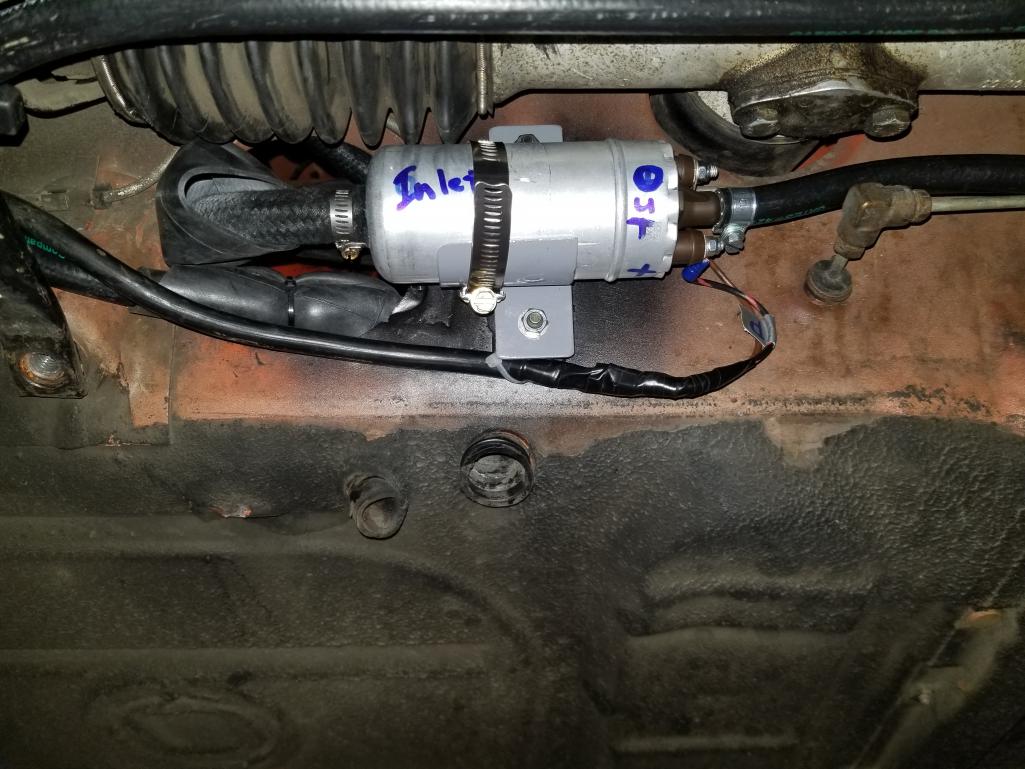
Posted by: partsguy22 Feb 8 2023, 09:09 AM
Thanks Clay
Here is the mount in question,
I designed it to mount Pumps on our EFI converted early 911s and 912s but it also fits a 914 depending on pump diameter (the 914 gravel pan is shaped differently and has a bit less room than a 911/912 )
I am redesigning the mount to better fit a 914 I'll post up pics when they get finished up
Attached thumbnail(s)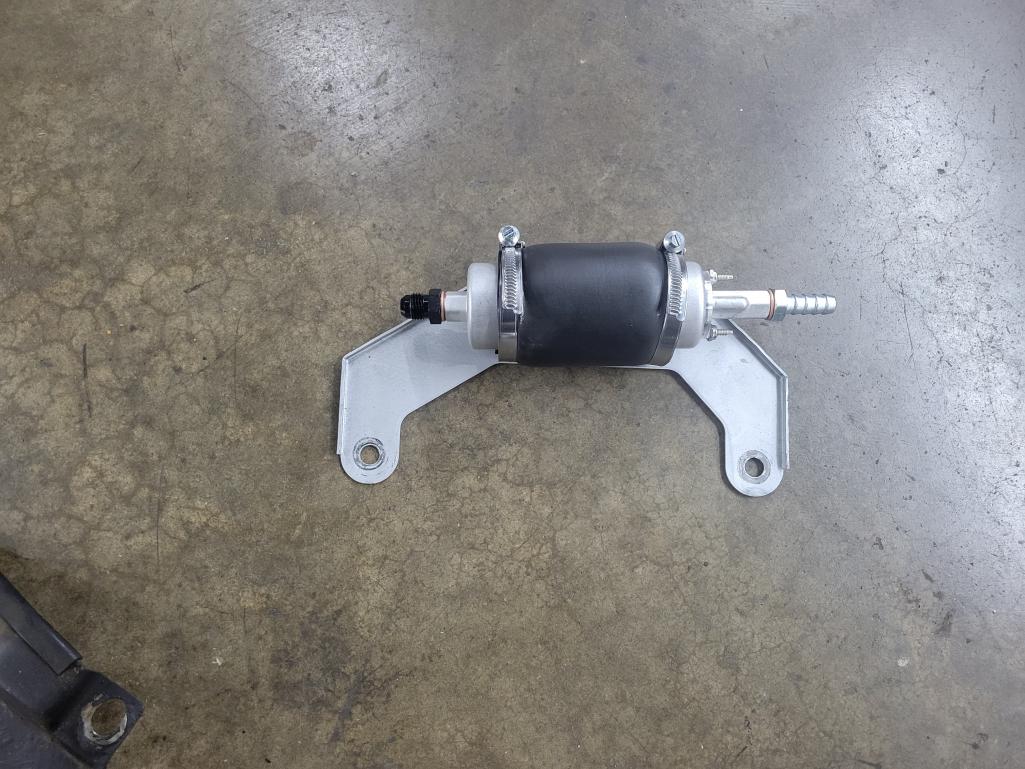
Posted by: partsguy22 Feb 8 2023, 09:15 AM
This is it mocked up on a car
As you can see it needs to go forward about 1.5" and /or bend slightly up
it sits that far back to clear the rack on a 911/912
Attached thumbnail(s)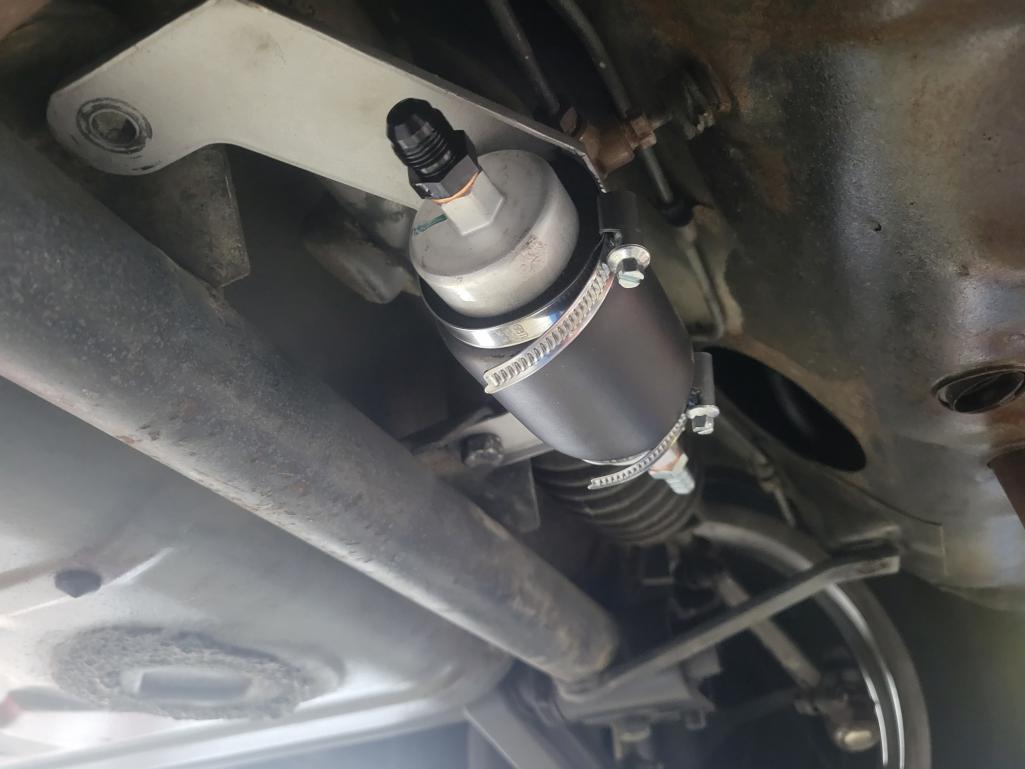
Posted by: ClayPerrine Feb 8 2023, 02:55 PM
You could always put the pump on top of the bracket.....
Clay
Posted by: jim_hoyland Feb 8 2023, 05:23 PM
Mounted mine in the front trunk; ball valve >Filter>Pump>Pressure Gauge
Easy to trouble shoot, change filter as well as the pump
Made a Lexan shield to protect the whole thing
Attached image(s)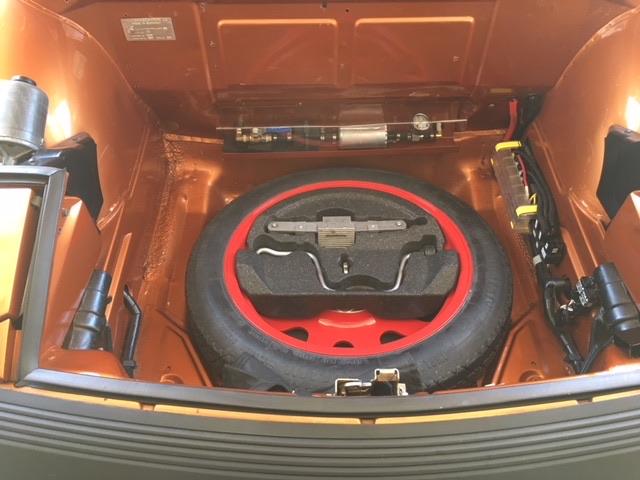
Powered by Invision Power Board (http://www.invisionboard.com)
© Invision Power Services (http://www.invisionpower.com)
